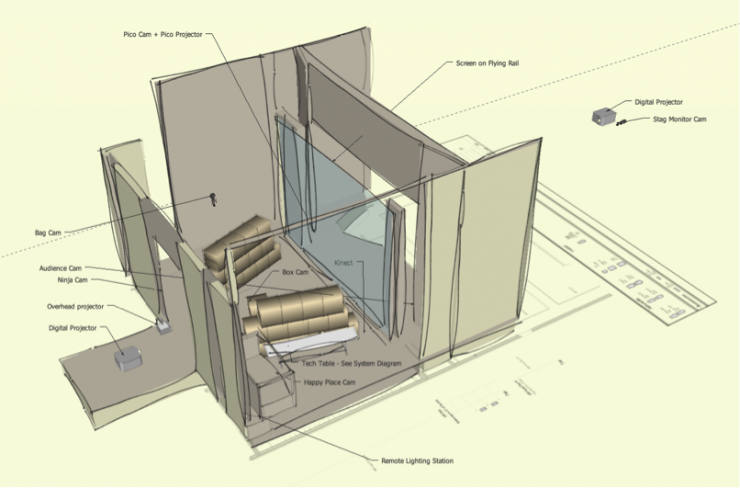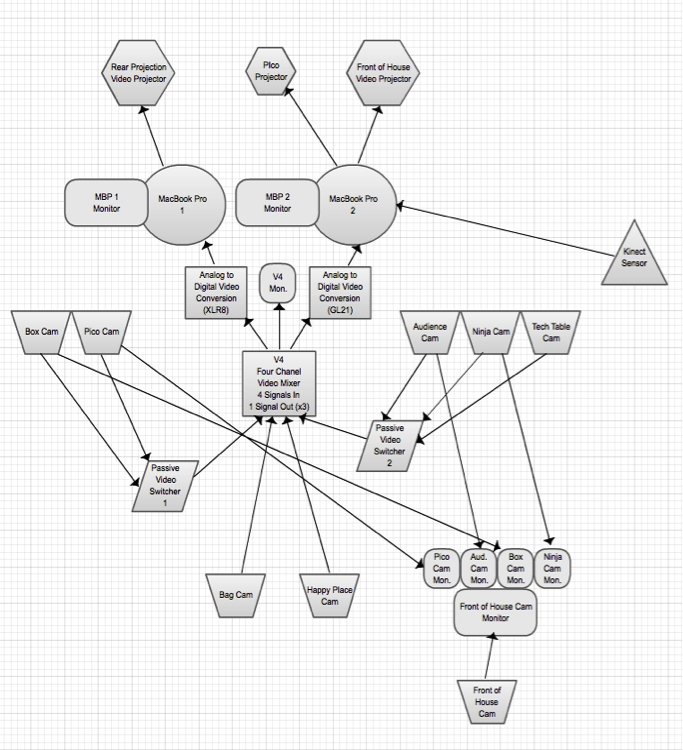Media Design in the Rehearsal Hall Part 3
This blog series offers a multi-disciplinary approach to achieve the best practices for collaboration in the creative and production process of incorporating digital media into live performance.
A type of interactive media that is common and essential in rehearsal is the use of live cameras. When using live cameras there are latency issues, so it is best to give the performers enough rehearsal time to adjust to the delay between video capture and display. In rehearsal we should try to simulate the production set-up as much as possible. If you can’t afford to have HD cameras in the rehearsal hall, use a cheap camera, a cheap projector, or monitor and start rehearsing with the live footage. Performers react differently when working alongside a digital version of another character than a live performer standing in front of them. Performance changes in subtle and not-so subtle ways when framed inside a monitor, or placed within the confines of a projection surface.
With everything that has to happen in tech week, there isn’t time to explore the correct angle, or framing of a shot or to really discover the nuance of a performance. By incorporating the live camera and playback method in rehearsal, the actors and the director have the chance to shape a refined, rich performance. And the designer has the ability to really explore camera angle and framing—things that convey meaning all by themselves.
Performance changes in subtle and not-so subtle ways when framed inside a monitor, or placed within the confines of a projection surface.
A real world example of the use of cameras in a production is Survivor’s Way, a solo show by Alex Oliszewski that I co-designed. The production utilized eight live-feed cameras (See Figures 1 and 2) that made it possible to implement Oliszewski’s plan “to composite, record, augment in real time, as well as perform blob tracking and motion detection on any of the live video signals.” There was a green screen onstage where we performed live keying and compositing. Yet, we decided not to have any cameras or interactive media in the beginning of rehearsals: the exact opposite of what I have been arguing in my previous posts.


For the first few weeks, the director, Brian Foley, rehearsed with Alex without any technology in the room. The reason for this choice was so that the performer had a firm understanding of his role and the arc of the story. This method worked because we knew we would be rehearsing with all the gear in the performance space for roughly two and a half weeks. Our last weeks of rehearsal became a cross between a traditional rehearsal and a typical tech rehearsal process.
The interactive media in Survivor’s Way went beyond being a character. The entire story revolved around the use of media. It was not only embedded into the story and the structure of the piece, but was also incorporated into the architecture of the set, creating a multi-layered feedback loop. This type of work could not be mounted without close-to-show conditions as early as possible. Rehearsing under close-to-show conditions allowed the director, performer, designer, and the entire production team to truly explore how the technology, the performance, and the rest of the design elements worked together.
We didn’t have our final system in place at the very beginning because it evolved through discoveries we made in rehearsal. Each day we integrated something new into the system for that day’s rehearsal or cut technology that didn’t work. Oliszewski notes, “While some of the moments when the system was implemented were pre-envisioned (e.g., the camera attached to a fly rail above a green-screened section on the floor), there were other moments in the performance that were discovered only after the system was up, running, and interacting with the performance.”
Another important distinction about Survivor’s Way is that the media technician running the show was onstage, thus becoming a performer. All the mixing of the eight cameras and the sensor work was done in real time like a DJ manipulating sound live onstage. Without proper rehearsal with the media system in place, the technician and the performer would not have been in sync enough to create a smooth and polished performance where the two could easily exchange a dialogue in real-time.
Media technician Graham Thorne, who mostly works as an Isadora programmer, states: “In an ideal world, its best to have a person like myself budgeted for and approached during the ideas stage so problems and ideas can be developed and solved from the beginning.” Similarly, Broadway media designer and professor of media design Jacob Pinholster observes, “The ideal would be to have technology and the technologist(s) in the room from the beginning.”
Rehearsing in the performance space with technology is an ideal way to create work and a luxury not all productions can afford.
Rehearsing in the performance space with technology is an ideal way to create work and a luxury not all productions can afford. From academic to Broadway practice, we do not truly offer adequate time in the creation process to integrate interactive media into live performance. However, there are companies like The Wooster Group, The Builders Association, and 3-Legged Dog who are a few exceptions. But rehearsal halls can certainly be equipped with low-cost gear. It doesn’t take much nor is it very expensive. Whatever our final system, no matter how complex, we can break it down to its core and replicate it on a smaller scale in rehearsal. It doesn’t have to be grand, robust, pixel packed, or powerful. It simply has to be a version or simulation of the final piece. If we are truly doing our jobs correctly, rehearsal will inevitably change what the final system will be anyway. After all, that is what rehearsal is all about.
In some cases, you need an entire system to truly explore the work being created, but for other projects a simple, sample system will suffice. Since no two projects are the same, we need to assess the production goals and work with the producer and the production manager to determine how to realistically incorporate technology both financially and schedule-wise. We’ve developed techniques over the centuries on how to rehearse without show conditions. We have rehearsal props, costumes, and boom boxes in the space playing music and/or sound cues. Performers use rehearsal furniture and sometimes large, rehearsal set pieces. With a little more forethought and a lot more planning, we can at the very least add a laptop, a projector, a screen and/or a monitor, as well as a sensor, camera, and technician in rehearsal. Having interactive media in the rehearsal hall allows the entire team the time to create a new, important dialogue between media and live performance. We just need the will and we can find a way.
Up Next: Accounting for Media in the Production Schedule.










Comments
The article is just the start of the conversation—we want to know what you think about this subject, too! HowlRound is a space for knowledge-sharing, and we welcome spirited, thoughtful, and on-topic dialogue. Find our full comments policy here